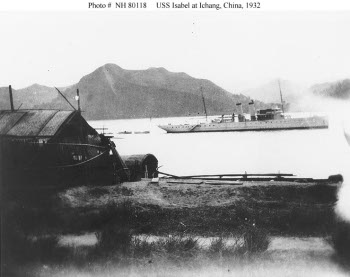![]() The Pacific War Online Encyclopedia
The Pacific War Online Encyclopedia
|
| Previous: Hydrographic Survey Ships | Table of Contents | Next: I-5, Japanese Submarine |

Naval
History and Heritage Command #NH 80118
I’chang (Yíchang; 111.317E 30.676N) is located on the Yangtze River at the entrance to the famous gorges that mark the limit of steamer navigability of the great river. Goods were transshipped to river barges at this point and pulled by coolies through the rapids. Because of its location, the city was subject to disastrous flooding from time to time.
The city first fell to the Japanese on 3 June 1940 as part of an
offensive designed to place military pressure on Chiang Kai-shek to accept a
negotiated settlement of the
China Incident on terms highly favorable
to the Japanese. There was no intention to hold the city and the
Japanese force withdrew on 16 June. However, the Navy wished to
establish a forward base for air
attack on Chungking, and the
Army retook the city. The loss of I'chang was a severe blow to the Kuomintang, severing most of the supply lines from Chungking to the front lines, but it was also a costly victory for the Japanese.
The Chinese attempted to retake the city in early October 1941 with a force totaling 71 divisions, and 13 Division found itself cut off and besieged for ten days. The situation became so desperate that the division staff began making preparations to burn their secret papers and the regimental flags, then commit suicide. However, the Japanese diverted forces from their campaign at Changsha and successfully relieved the city.
I'chang marked the limit of Japanese
control of the Yangtze
valley throughout the Pacific War. Following its capture, a debate broke
out int he Japanese high command over whether to withdraw some troops
from China in order to better train and equip the remainder. I'chang was
probably garrisoned by 13 Division and 39 Division when war broke out
in the Pacific.
References
Drea (2009)The Pacific War Online Encyclopedia © 2007, 2009, 2012, 2015 by Kent G. Budge. Index